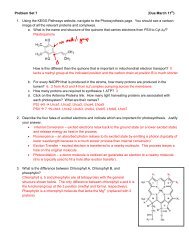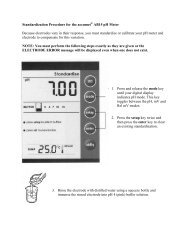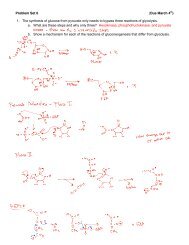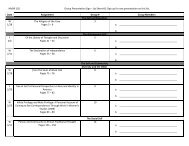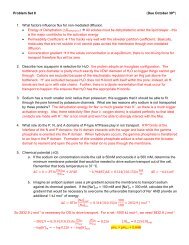Problem Set 5 (Due Sept 25th) 1. Draw a lipid containing stearic ...
Problem Set 5 (Due Sept 25th) 1. Draw a lipid containing stearic ...
Problem Set 5 (Due Sept 25th) 1. Draw a lipid containing stearic ...
- No tags were found...
You also want an ePaper? Increase the reach of your titles
YUMPU automatically turns print PDFs into web optimized ePapers that Google loves.
<strong>Problem</strong> <strong>Set</strong> 5 (<strong>Due</strong> <strong>Sept</strong> 30 th )<strong>1.</strong> <strong>Draw</strong> the Hawthorn projection (ring form) of Mannose and its C2 epimer. What is the common name ofthis epimer?2. Examine the sugar shown here.a. Is this an aldose or ketose? Pentose or hexose?b. Label each carbon appropriately (C1, C2, etc.)c. From the image, how can you be sure that it’s an epimerof glucose?d. Which sugar is it?e. <strong>Draw</strong> the sugar using a Hawthorn projection and a Fisherprojection.3. Sucrose is a common disaccharide. What is the full name of this sugar?4. What is meant by the term reducing sugar? Which of the common disaccharides discussed in class arenot reducing sugars? Justify your answer. What experiment can you do to determine if a disaccharideis reducing?5. Using Chimera or another 3D molecule viewer, open pdbID 4B7I (the last letter is eye, not el).a. Verify that this is an N-linked oligosaccharide. What is the residue number of the glycosylatedAsn?b. Does the protein follow the correct amino acid pattern for glycosyl transferase specificity? Bespecific – you book discusses three invariable features of N-linked sugars.c. Using a sketch like seen in Figure 8.19, map the sugars. For each glyosidic bond, determinethe linkage (e.g. α(14)). Hint: To determine the α/β orientation, you can set the focus to eachsugar and observe if the anomeric carbon orientation is axial (α) or equatorial (β).d. Are there any H-bonds between the oligosaccharide and amino acid side chains?e. <strong>Draw</strong> this oligosaccharide using a Hawthorn projection. Make sure to show the linkage to Asn.6. Discuss the differences between starch and cellulose. Make sure to consider the 3D structure of thepolymers and how each interacts with other polymers.7. Bacterial cell walls are made from repeating patterns of two modified sugars. <strong>Draw</strong> these sugars asthey would look in a cell wall. Discuss how linear polymers are connected in a cell wall.8. <strong>Draw</strong> a <strong>lipid</strong> <strong>containing</strong> <strong>stearic</strong> acid, linoleic acid and phosphatidylcholine. Recall that there arecommon positions on the glycerol backbone for each of these classes of molecules. Identifywhich regions of this molecule will occur on the surface of a <strong>lipid</strong> bilayer.9. Why are triglycerides not common components of biological membranes? What is their function?10. Describe two trends in membrane fluidity. How does cholesterol influence membrane fluidity?1<strong>1.</strong> The structure of the photosynthetic reaction center from Rps. viridis has been determined (pdbID1PRC). Please download this structure and use an appropriate program to show how this protein isembedded in a membrane. A good place to start would be to color all polar and ionic amino acids onecolor and the non-polar amino acids another color. You can select types by SelectResidue aminoacid category.12. This exercise will guide you through the last (and most useful) method to predict protein structure andfunction. There are A LOT of protein structures known; biochemists use this to their advantage. Ifwe’re trying to predict the structure of an unknown protein, we can commonly find the structure of a
similar protein and use that as a guide to calculate a homology model. I stress that this is only a modeland not a real structure, but nonetheless, it can be incredibly useful.On the last page of this problem set, you’ll find two FASTA sequences: one for Chain A of a known crystalstructure and another from an E. coli protein that has unknown function but has a high degree of similarity withthe known protein.The first step to developing a homology model is to align the sequences. When you do a blast search, this isexactly what is happening behind the scenes; a computer is taking your protein (or DNA sequence) andaligning it with all known protein to find the best matches. We’re going to do this manually for these twoproteins.• From the ExPASy page, select genomics then sequence alignment. As you can see, there are a lot ofoptions – I like to use the ClustalW2 server, but you can try any of them.• On the ClustalW2 site, input the sequences seen below.• On the step 3 box, click on more options and select Pearson/FASTA as the output format.• Submit this project and wait for the alignment to complete. This should be very quick.• In this example, the sequences align very nicely, so there are not any gaps in the core region. Do note,however, that there are some dashes at the beginning and end of the unknown protein – this meansthat there are not any amino acids that align with the crystal structure at this point.• Download the alignment file and paste it into a word document. Save this document as at .txt file (thisis really important – Chimera won’t recognize the .doc or .docx format as an alignment file)Open this file in Chimera (make sure to select aligned FASTA as the format).Ask Chimera to load any structures that are available. (Structures Load structures). I would recommendthat you hide chain B and set the focus on Chain A (select all of Chain A and then Action focus).Use Chimera to predict the secondary structural elements for the unknown protein (Structure SecondaryStructure). Does the structure prediction match up with the actual structure of 3N73?Use Chimera to determine the % Identity. This can be found under the Info menu. You may have tomanually open the reply log to see the value. This is available under the Favorites menu.Now we’re actually going to build a homology model of the unknown protein using 3N73 Chain A as atemplate. Go back to the sequence alignment tab.• Select Structure Modeller tools.• The target will be the unknown protein and the template will be 3N73_A. Make sure these are selected.• Now select ok. If you are asked to input a code for Modeller, use MODELIRANJE• Wait for the sequence to complete.Chimera will build and display multiple models. When we show several structures on top on each other, this iscalled a structure ensemble. Carefully inspect the ensemble – what regions of the protein appear to be themost similar to the template structure? What regions tend to deviate? Does this make sense based onwhat we’ve learned about protein structure?There is one loop region on the exterior of the protein that seems to have the most deviation from thetemplate. Justify this based on your sequence alignment.Please provide an image of the homology model. You can either take a screen shot or use the save imagecommand in the file menu.
3N73:A|PDBID|CHAIN|SEQUENCEMTNIQKRFYKGRVALNVLANNIENAKDIFEAAEGYVVVGVLSKDYPTVEEAVTAMKAYGKEIEDAVSIGLGAGDNRQAAVVAEIAKHYPGSHINQVFPSVGATRANLGGKDSWINSLVSPTGKVGYVNISTGPISAAGEEKAIVPIKTAIALVRDMGGNSLKYFPMKGLAHEEEYRAVAKACAEEGFALEPTGGIDKENFETIVRIALEANVERVIPHVYSSIIDKETGNTKVEDVRELLAVVKKLVDQYA>gi|571159785|emb|CDL57015.1| putative periplasmic protein [Escherichia coli ISC56]MKLTPNFYRDRVCLNVLAGSKDNAREIYDAAEGHVLVGVLSKNYPDVASAVADMRDYAKLIDNALSVGLGAGDPNQSAMVSEISRQVQPQHVNQVFTGVATSRALLGQNETVVNGLVSPTGTPGMVKISTGPLSSGAADGIVPLETAIALLKDMGGSSIKYFPMGGLKHRAEFEAVAKACAAHDFWLEPTGGIDLENYSEILKIALDAGVSKIIPHIYSSIIDKASGNTRPADVRQLLEMTKQLVK



